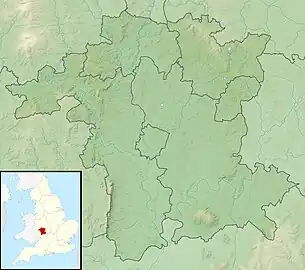| River Salwarpe | |
|---|---|
 River Salwarpe in Vines Park, Droitwich | |
 Location within Worcestershire | |
| Location | |
| Country | England |
| Counties | Worcestershire |
| Physical characteristics | |
| Mouth | |
• location | River Severn |
• coordinates | 52°14′20″N 2°14′00″W / 52.2388°N 2.2334°W |
| Length | 32.8 km (20.4 mi) |
| Basin size | 196 km2 (76 sq mi) |
| Discharge | |
| • location | Harford Hill |
| • average | 1.35 m3/s (48 cu ft/s) |
The River Salwarpe is a 20.4 miles (32.8 km) long river in Worcestershire, England. It is a left bank tributary of the River Severn, which it joins near Hawford.[1][2]
Course
The Salwarpe is formed by the confluence of the Battlefield and Spadesbourne Brooks in Bromsgrove, it then passes Stoke Prior, Upton Warren, Wychbold, Droitwich.[1] Downstream of Droitwich, it passes Salwarpe, and then meets the River Severn, near Hawford.[2]
Andrew Yarranton attempted unsuccessfully to make it navigable in the 1660s, but in the 21st century a stretch of the river in Droitwich was canalized to link the Barge and Junction sections of the Droitwich Canal.[3][4]
Tributaries include the Elmbridge, Hadley and Hen brooks.[1][2]
Hydrology
The flow of the Salwarpe has been measured in its lower reaches at Harford Hill since 1958. The long-term record shows that the catchment of 184 square kilometres (71 sq mi) to the gauging station yielded an average flow of 1.35 cubic metres per second (48 cu ft/s).[5] The highest river level recorded at the station occurred in January 1960 with a height of 2.69 metres (8 ft 10 in), giving a corresponding flow of 39 cubic metres per second (1,400 cu ft/s).[6]
The Salwarpe catchment upstream of the station has an average annual rainfall of 666 millimetres (26.2 in) and a maximum altitude of 294 metres (965 ft) at Beacon Hill, in Lickey Hills Country Park at its north-eastern edge. Land use is primarily agricultural arable and grassland.[7]
Water quality
The Environment Agency measure water quality of the river systems in England. Each is given an overall ecological status, which may be one of five levels: high, good, moderate, poor and bad. There are several components that are used to determine this, including biological status, which looks at the quantity and varieties of invertebrates, angiosperms and fish. Chemical status, which compares the concentrations of various chemicals against known safe concentrations, is rated good or fail.[8]
The water quality of the Salwarpe and its tributaries was as follows in 2016.
| Section | Ecological Status | Chemical Status | Overall Status | Length | Catchment |
|---|---|---|---|---|---|
| Battlefield Bk - source to conf Spadesbourne Bk[9] | Moderate | Good | Moderate | 10.4 kilometres (6.5 mi) | 19.1 square kilometres (7.4 sq mi) |
| Spadesbourne Bk - source to conf Battlefield Bk[10] | Moderate | Good | Moderate | 5.1 kilometres (3.2 mi) | 10 square kilometres (3.9 sq mi) |
| Salwarpe - source to conf Elmbridge Bk[11] | Poor | Good | Poor | 21.9 kilometres (13.6 mi) | 58.3 square kilometres (22.5 sq mi) |
| Elmbridge Bk - source to conf R Salwarpe[12] | Poor | Good | Poor | 10.1 kilometres (6.3 mi) | 31.5 square kilometres (12.2 sq mi) |
| Hadley Bk - source to conf R Salwarpe[13] | Poor | Good | Poor | 26.4 kilometres (16.4 mi) | 55.3 square kilometres (21.4 sq mi) |
| Salwarpe - conf Elmbridge Bk to conf R Severn[14] | Poor | Good | Poor | 10.8 kilometres (6.7 mi) | 21.8 square kilometres (8.4 sq mi) |
The water quality of all the riverine waterbodies in the lower catchment have regressed from moderate in 2009 to poor in 2016. The two upper tributaries remained at moderate. Chemical quality is good in the Salwarpe and its four monitored tributaries.
See also
References
- 1 2 3 "Salwarpe - source to conf Elmbridge Bk". Catchment Data Explorer. Environment Agency. Retrieved 6 November 2017.
- 1 2 3 "Salwarpe - conf Elmbridge Bk to conf R Severn". Catchment Data Explorer. Environment Agency. Retrieved 6 November 2017.
- ↑ . Dictionary of National Biography. London: Smith, Elder & Co. 1885–1900.
- ↑ "Restoration of the Droitwich Canals Non Technical Summary" (PDF). British waterways. Archived from the original (PDF) on 24 September 2010. Retrieved 6 November 2017.
- ↑ "54011 - Salwarpe at Harford Hill Daily Flow Data". National Rivers Flow Archive. Centre for Ecology & Hydrology. Retrieved 6 November 2017.
- ↑ "54011 - Salwarpe at Harford Hill Peak Flow Data (Annual Maximum)". National Rivers Flow Archive. Centre for Ecology & Hydrology. Retrieved 6 November 2017.
- ↑ "54011 - Salwarpe at Harford Hill – Catchment Info". National Rivers Flow Archive. Centre for Ecology & Hydrology. Retrieved 6 November 2017.
- ↑ "Glossary (see Biological quality element; Chemical status; and Ecological status)". Catchment Data Explorer. Environment Agency. 6 November 2017.
- ↑ "Battlefield Bk - source to conf Spadesbourne Bk". Catchment Data Explorer. Environment Agency.
- ↑ "Spadesbourne Bk - source to conf Battlefield Bk". Catchment Data Explorer. Environment Agency.
- ↑ "Salwarpe - source to conf Elmbridge Bk". Catchment Data Explorer. Environment Agency.
- ↑ "Elmbridge Bk - source to conf R Salwarpe". Catchment Data Explorer. Environment Agency.
- ↑ "Hadley Bk - source to conf R Salwarpe". Catchment Data Explorer. Environment Agency.
- ↑ "Salwarpe - conf Elmbridge Bk to conf R Severn". Catchment Data Explorer. Environment Agency.